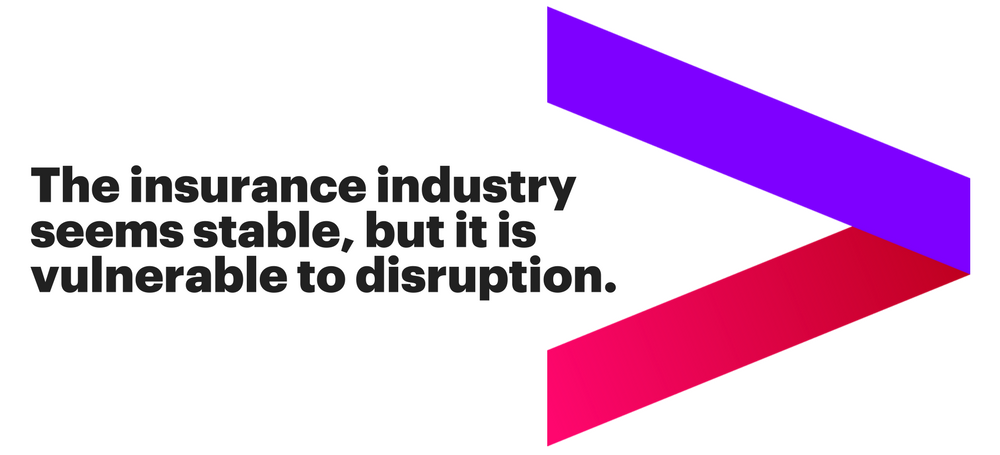There is a growing recognition among insurers that insurtech represents more of an opportunity than a threat and that insurers should seek to collaborate closely with this latest breed of technology-fueled startups.

Insurtech is enjoying record growth. While 2016 saw $1.7 billion in insurtech investments, things are only picking up in 2017.

There is a growing recognition among insurers that insurtech represents more of an opportunity than a threat and that insurers should seek to collaborate closely with this latest breed of technology-fueled startups.

Get Involved
Our authors are what set Insurance Thought Leadership apart.
|
Partner with us
We’d love to talk to you about how we can improve your marketing ROI.
|

John Cusano is Accenture’s senior managing director of global insurance. He is responsible for setting the industry group's overall vision, strategy, investment priorities and client relationships. Cusano joined Accenture in 1988 and has held a number of leadership roles in Accenture’s insurance industry practice.
Executive teams must urgently stop thinking about cyber risk as an IT issue and lead a shift to managing its impact across the entire organization.

Get Involved
Our authors are what set Insurance Thought Leadership apart.
|
Partner with us
We’d love to talk to you about how we can improve your marketing ROI.
|

Jason J. Hogg serves as chief executive officer of Aon Cyber Solutions. He is based in the firm’s New York office and was first appointed in May 2017. Hogg is responsible for the firm’s global operations and growth strategies, bringing to the role a wealth of experience in technology, finance and business leadership. Most recently, Hogg served as a senior advisor and CEO partner for Tritium Partners, a private equity firm focused on buyouts of growth companies.

For some time now, you've seen me mention our Innovator's Edge platform, where we have built the best data base, bar none, on insurtechs. We're now taking the next step, adding a framework that lets you make connections that will help you on your innovation journey.
Insurance Thought Leadership is launching the Innovator’s Edge Network, a free professional network for insurance innovation executives who are leading the transformation of insurance. The network is one of several tools available within our Innovator’s Edge platform that insurance executives can access to achieve growth through innovation.
You can join the network today at www.InnovatorsEdge.io and build a professional profile that will connect you with people, discussion groups and events that support your needs.
The free membership is designed for executives within the insurance industry who seek to expand their professional network and meet fellow innovators—both from traditional insurance companies and insurtech entrepreneurs. The IE Network also helps members follow innovation trends and developments focused on their areas of interest and gain insights to the potential impact of innovation on the industry, quickly, deeply and efficiently.
We have made it super simple for you to join the IE Network: Just go to www.InnovatorsEdge.io, register to join and provide a little information about yourself and the areas of insurance innovation that are of most interest to you.
Within each area of interest, you will be able to find potential connections, participate in online discussion forums—to share ideas, ask and answer questions and collaborate in a professional and respectful environment—and access curated analysis and perspectives from some of the most significant thought leaders in the industry.
The events feature allows you to browse future insurance and innovation events, identify those of interest and signal others within the IE Network that you are attending, speaking or sponsoring. The tool also allows users to manage face-to-face meetings at events with other network members, and manage your schedule.
Your free IE Network membership also will get you a peek behind the curtain of the premium features of Innovator’s Edge, which is our strategic growth platform that connects the insurance industry with the top innovators and entrepreneurs delivering insurtech solutions and exponential technologies that are creating growth opportunities for insurance.
Last, and most importantly, we want you to invite your friends and colleagues from the insurance innovation community to the IE Network, join you in categories and groups, join you in positions of leadership and join you in becoming an insurance innovation executive.
Have a great week.
Paul Carroll
Editor in Chief
Get Involved
Our authors are what set Insurance Thought Leadership apart.
|
Partner with us
We’d love to talk to you about how we can improve your marketing ROI.
|

Paul Carroll is the editor-in-chief of Insurance Thought Leadership.
He is also co-author of A Brief History of a Perfect Future: Inventing the Future We Can Proudly Leave Our Kids by 2050 and Billion Dollar Lessons: What You Can Learn From the Most Inexcusable Business Failures of the Last 25 Years and the author of a best-seller on IBM, published in 1993.
Carroll spent 17 years at the Wall Street Journal as an editor and reporter; he was nominated twice for the Pulitzer Prize. He later was a finalist for a National Magazine Award.
...everything in the world around it has. Insurers cannot afford to be complacent when disruption has upended other industries.

Insurers cannot afford to be complacent when disruption has upended other industries. The industry can, and must, embrace change and the future-fearlessly.
Insurance hasn’t changed much in 200 years. It’s still about capital placed against risk. It’s still about creating tailored products for customers. It’s still about using information to sell through channels, to generate returns for a company. Except that capital now includes venture capital and peer-to-peer funding. Risk now includes cyber, pandemic, micro. Tailored products? Think episodic, pay-as-you-go, parametric. Information? Humanity produces 2.5 quintillion bytes of data every day (a quintillion has 18 zeroes). Customers span millennials and high-net-worth boomers, each of whom expects personalized service. Insurance hasn’t changed much in 200 years, but everything around it has. At its highest level, the insurance industry appears stable. Profits are solid, with average pre-tax RoE levels from 2010 to 2016 between 10% and 12% globally. Company rankings are stable, and share price performance is solid across the globe. That sentiment is confirmed by the Accenture Disruptability Index, a global, cross-industry study of how incumbent industries will likely fare in the face of disruption. On a scale of zero to one, with zero being minimally disrupted and one being highly disrupted, insurance scored 0.37. See also: Time to Formalize Insurance Career Path The study also identified four distinct periods of disruption, each with its particular implications and corrective actions. Insurance is in the “vulnerable” period of disruption, characterized by structural inefficiencies and low innovation that lead to low productivity. These pressures compress profitability but create a high barrier to entry that can hold off disruption—for now. Insurers cannot afford to be complacent. The industry’s future disruptability scored 0.68—above the median of 0.57 and among the highest scores in the study. An estimated 30% to 40% of EBITDA is projected to be at risk by 2020, and the industry has already experienced significant disruption. Moreover, executives know that innovation is essential not just to remaining competitive but to surviving.
To fend off disruption, insurers need to take targeted action. They must optimize to address structural productivity and inject new digital technologies to upgrade core offerings at lower cost. This last point is worth repeating: Core transformation is critical to fending off disruption. I’ll keep coming back to this throughout this blog series, as we discuss ways to transform the core, and how doing so can fuel innovation.
Feel the fear—and make change
Insurance is at the edge. It’s vulnerable to disruption and under threat of being made redundant if it continues to bask in the status quo. But insurance is not the only industry caught unprepared. Accenture research found that 93% of chief strategy officers agreed that they will be disrupted within five years—but only 20% feel highly prepared to deal with it.
What’s more, longevity comes with perks. Insurers have data, distribution channels and innovation practices that many startups would envy. Insurers are more than capable of turning disruption into an opportunity.
Over the course of this blog series, I’ll explain how insurers can meet disruption head-on. How they can create efficiencies in their core business and innovate to create revenue streams for the future. How to not just meet customer expectations, but exceed them. Why legacy systems don’t have to be an obstacle to change. And how to make the wise pivot to become an organization that is equipped for success in a digital economy.
See also: Unfair Perception of Insurance
Insurance hasn’t changed much in 200 years, but everything around it has. The insurance industry can, and must, embrace the future—fearlessly.
Insurers cannot afford to be complacent. The industry’s future disruptability scored 0.68—above the median of 0.57 and among the highest scores in the study. An estimated 30% to 40% of EBITDA is projected to be at risk by 2020, and the industry has already experienced significant disruption. Moreover, executives know that innovation is essential not just to remaining competitive but to surviving.
To fend off disruption, insurers need to take targeted action. They must optimize to address structural productivity and inject new digital technologies to upgrade core offerings at lower cost. This last point is worth repeating: Core transformation is critical to fending off disruption. I’ll keep coming back to this throughout this blog series, as we discuss ways to transform the core, and how doing so can fuel innovation.
Feel the fear—and make change
Insurance is at the edge. It’s vulnerable to disruption and under threat of being made redundant if it continues to bask in the status quo. But insurance is not the only industry caught unprepared. Accenture research found that 93% of chief strategy officers agreed that they will be disrupted within five years—but only 20% feel highly prepared to deal with it.
What’s more, longevity comes with perks. Insurers have data, distribution channels and innovation practices that many startups would envy. Insurers are more than capable of turning disruption into an opportunity.
Over the course of this blog series, I’ll explain how insurers can meet disruption head-on. How they can create efficiencies in their core business and innovate to create revenue streams for the future. How to not just meet customer expectations, but exceed them. Why legacy systems don’t have to be an obstacle to change. And how to make the wise pivot to become an organization that is equipped for success in a digital economy.
See also: Unfair Perception of Insurance
Insurance hasn’t changed much in 200 years, but everything around it has. The insurance industry can, and must, embrace the future—fearlessly.
Get Involved
Our authors are what set Insurance Thought Leadership apart.
|
Partner with us
We’d love to talk to you about how we can improve your marketing ROI.
|

Michael Costonis is Accenture’s global insurance lead. He manages the insurance practice across P&C and life, helping clients chart a course through digital disruption and capitalize on the opportunities of a rapidly changing marketplace.
Claims represents the most important customer touchpoint in the entire insurance journey. Nothing affects carriers’ bottom lines like claims.

"Claims is a significant part of the insurance value chain and, in our view, offers the largest potential for innovation. Many insurers are struggling with the dynamic of reducing costs while providing a positive customer experience. Recently in the U.S. and the U.K., many of the large insurers have experienced significant underwriting losses, for core products like motor, due to poor claims experience, deteriorating driving behavior, and rising repair/medical costs." – Sam Evans, managing director at Eos Venture PartnersWhile prevention does continue to get better, accidents and unforeseen incidents are always going to occur, so claims certainly aren’t going away anytime soon. When a claim does occur, insurers have the opportunity to impress their customers at that precise moment when those customers need, and appreciate, their insurance the most. We have noted throughout this content series (for instance in our earlier post on insurer priorities) the growing importance of customer-centricity to insurers. And claims – as the key, and in some cases only, consumer touchpoint – has become a key avenue of engagement. If insurers can provide excellent customer service throughout the claims experience, removing friction from the process wherever possible, then they are more likely to retain their policyholders and even open cross-selling opportunities. 1. Customer Experience in Claims Is customer experience (CX) a core focus for claims departments? We asked carriers whether customer experience (CX) was a key factor within their claims departments; 69% replied "yes" and 26% "somewhat." The trend toward the growing importance of customer-centricity within every insurance function is therefore borne out handsomely by the statistics.
 Looking across our lines, we see a consistently high focus on CX in claims, except for in life, which trails somewhat. This probably reflects a historic lack of touchpoints (often just policy renewals and death) and, as an extension of this, the more limited opportunities for new business and cross-selling. We encountered a similar lag with this line in our earlier installment on marketing and customer-centricity.
Looking across our lines, we see a consistently high focus on CX in claims, except for in life, which trails somewhat. This probably reflects a historic lack of touchpoints (often just policy renewals and death) and, as an extension of this, the more limited opportunities for new business and cross-selling. We encountered a similar lag with this line in our earlier installment on marketing and customer-centricity.
"Will claims call centers evolve from the current model of large numbers of people predominantly performing standard operations and having scripted conversations to a much smaller number of ‘problem solvers’ being available to support customers when something out of the ordinary creates an exception in the automated processes?" – Ian Thompson, EMEA chief claims officer at ZurichSee also: Using Catastrophes to Rethink Claims (Part 3) Does automation play a role in the claims-handling process? Customers want frictionless experiences when making a claim. Certainly most young claimants (digital natives) would prefer to do everything through an app or portal rather than filling out paper forms, and this has seen some insurers embrace non-traditional channels such as WhatsApp for submitting claims materials. In addition to slickness, customers want speed or, where speed is not possible, clarity as to their claim's status.
 This level of service can only be provided effectively through recourse to automation in some degree – so that a large portion of uncomplicated claims can be processed straight-through and the customer either notified of the outcome or given a resolution date, all at the click of a button. 46% of carriers indicated that they have an automated claims-handling process, a figure we expect to become a majority soon. This stat does not necessarily imply that the majority of claims will soon be automated, merely that automation will soon be in the mix for the majority of carriers.
This level of service can only be provided effectively through recourse to automation in some degree – so that a large portion of uncomplicated claims can be processed straight-through and the customer either notified of the outcome or given a resolution date, all at the click of a button. 46% of carriers indicated that they have an automated claims-handling process, a figure we expect to become a majority soon. This stat does not necessarily imply that the majority of claims will soon be automated, merely that automation will soon be in the mix for the majority of carriers.
"There is no doubt that insurance, in general, and claims, in particular, will see significant changes through the automation of knowledge work. Customer choice and the importance to the customer of the claims service will mean that human involvement in the process will always be necessary. However, as claims leaders, we will need to rethink our operating models in the light of emerging technology." – Ian ThompsonThere are many different workflows for claims management (depending on the type and complexity of the claim, as well as its value), and claims automation generally only means automating some of these. Although automation has connotations of cost-cutting (and this is definitely a factor), it can also be argued that less staff time spent on routine claims allows more staff time for high-stakes claims, meaning claims management can become customer-driven rather than process-driven. 2. Claims Prevention and Mitigation How much focus do (re)insurers have on claims loss mitigation? We asked carriers about their level of focus on claims loss mitigation; 57% replied that they had "a lot" and 39% "some" focus. North America leads our other regions in terms of having "a lot" of focus. We further explore the specificity of the North American insurance market in our forthcoming regional profile on the continent, which you can, of course, access immediately by downloading the full Trend Map. Will IoT affect the claims department? IoT fundamentally allows carriers (and other ecosystem players, in cooperation but also in competition with insurers!) to move from risk management to risk prevention by providing insights to bring down policyholder risk. In this sense, the overriding impact of IoT on claims is the reduction – or even outright elimination – of claims. This goal is perfectly aligned with customer wishes, and there are many more ways IoT can boost customer-centricity in claims. If event data can be captured automatically, this doesn’t just help eliminate fraudulent claims (which ultimately cost law-abiding customers), it also removes a lot of friction from the process of filing claims and means that business-as-usual can be resumed as early as possible. An example of this would be a temperature-sensitive cargo insured against temperature rises above a certain point, whereby a temperature sensor – in conjunction with blockchain and smart contracts – could trigger claims automatically if the limit were exceeded. This way, mitigation could begin straightaway with minimal head-scratching; in this example, that might involve immediately re-ordering the compromised cargo. In our earlier section on Internet of Things, 60% of respondents selected claims as one of the departments that would benefit the most from IoT, and this is largely borne out in the responses of carriers here: 53% of insurers and reinsurers believe that IoT will affect their claims department. Among our lines, IoT's impact on claims trails in life, unsurprising given that IoT-enabled life programs – if they exist at all – generally sit behind connected health initiatives (which get the plaudits). As the cost of sensors and connected devices continues to fall, we expect to see further growth in the connected-claims universe to the benefit of customers and carriers alike, across all lines. While the potential of sensor-led approaches to manage down risk remains hypothetical for many use cases (there are simply not enough long-term studies yet) and while there are inevitably other well-positioned ecosystem players with a shot at the prize, a more immediately tangible IoT-enabled saving is in relation to fraud, which we examine in our next installment. Telematics providers may not, in the end, make you a better driver – but the G-forces can tell them exactly what has gone on with your car. And with your insurer as it were in the passenger seat, you will feel rather less able to lie to the company.

Get Involved
Our authors are what set Insurance Thought Leadership apart.
|
Partner with us
We’d love to talk to you about how we can improve your marketing ROI.
|

Alexander Cherry leads the research behind Insurance Nexus’ new business ventures, encompassing summits, surveys and industry reports. He is particularly focused on new markets and topics and strives to render market information into a digestible format that bridges the gap between quantitative and qualitative.Alexander Cherry is Head of Content at Buzzmove, a UK-based Insurtech on a mission to take the hassle and inconvenience out of moving home and contents insurance. Before entering the Insurtech sector, Cherry was head of research at Insurance Nexus, supporting a portfolio of insurance events in Europe, North America and East Asia through in-depth industry analysis, trend reports and podcasts.
It is estimated that, by the year 2020, there will be 117 million Americans who will need assistance with daily living and healthcare issues.

First, the good news. Large employers are beginning to provide extended, paid family leave for employees who become full-time caregivers. This is a much-needed sea change in the evolving trend of providing family-friendly employee benefit programs. The bad news is that it is estimated that, by the year 2020, there will be 117 million Americans who will need assistance with daily living and healthcare issues. At the same time, it is estimated that only 45 million family members will be available to help care for their loved ones. The majority of these 45 million caregivers are working age adults who are now, or will be, primarily responsible for the care of seniors or young children in need of 24/7/365 care.
The impact of the caregiver crisis facing both public and private employers is staggering. A recent study by Farleigh Dickinson University's PublicMind on behalf of Alzheimer’s New Jersey found that 29% of respondents are either now caring, or have cared, for someone with dementia. Among the study participants, 25% reported spending 40 hours or more per week as a caregiver. It gets worse: 65% were financially affected, 85% reported their emotional well-being was damaged, including anxiety and depression, and 60% reported their physical health was hurt. In addition, 53% reported they had no other family member to help, and 72% reported strained family relations as a result. Another recent study showed that 29% of caregiver employees declined promotion opportunities, and 12% actually quit their jobs due to the emotional stress involved.
I know. I was one of those people and can check every box. (See Looming Caregiver Crisis in the U.S. 5/18/16)
I am delighted to hear that progressive employers are now addressing the problem by providing expanded paid family leave for employees who become caregivers. Deloitte recently announced, as part of a Family Comes First program, that it is providing as much as 16 weeks of paid leave for employee caregivers when they become primarily responsible for the care of seniors.
See also: Looming Caregiver Crisis in the U.S.
Extended paid time off for caregivers is essential to help employees maintain their own physical, mental and emotional health. There is no way to prepare to become a caregiver. It will be the toughest job you have ever had, and you have no choice. Your job and life become secondary, or just a welcome diversion.
As a caregiver for both my mom and dad in the final years of their lives, I had to learn how to deal with Medicare, Medicaid, their finances, banking, Social Security, pension, living wills, estates, taxes, power of attorney, selling a home, healthcare directive and proxies, DNR (Do Not Resuscitate orders), doctors appointments, proper and appropriate prescriptions, surgery, slips, falls and broken bones, housekeepers and visiting nurses, to name a few. I also had to become an expert in congestive heart failure, diabetes, clogged carotid arteries, dementia and depression. One night, I got a call that both my mom and dad were on the way to the emergency room in two different ambulances at the same time. The only good news was that they were going to the same hospital.
Mark Perzinski, a 35-year veteran in the employee benefit industry, agrees that these extended paid leave programs are a great start that “allow employers to fully protect their best assets, their employees, by providing a paid family first policy. The problem is these caregivers need a daily road map. We provide that road map.”
Mark is currently working with Philip Gow at Global Institutional Solutions (www.gisandco.com), developing strategic marketing relationships for their caregiver services in the employee benefits industry. This is a one-of-a-kind program that provides 24/7/365 access to an extensive library of user-friendly resources, links, databases and, as needed, a caregiver specialist. The service also includes resources for elder fraud and estate settlements, Medicare assistance, guidelines and screening, along with caregiver access via tablets and smartphones that provides resources and tools at your fingertips -- all for pennies per month per employee. There is also an optional telemedicine service that gives caregivers 24/7/365 access to physicians to help address common illnesses, stress, anxiety, depression and personal wellness.
Gow stated, “We designed this program to address the caregiver stress syndrome that affects 42 million Americans and 21% of households. The economic impact is estimated at $500 billion per year, up from $375 billion in 2007.”
This is a robust model that can help track and manage medical appointments, prescription drug regiments and adherence, while providing access to databases on everything from federally rated nursing homes, assisted living facilities and dialysis centers, to housekeeping and daily living services. Caregivers also have direct access to resources for chronic medical conditions such as oncology, head trauma, pulmonary vascular disease, congestive heart disease and dementia.
See also: 5 Trends for Employers to Watch in 2018
The only technology available to me was my cell phone and answering machine.
For more information about the caregiver program at Global Institutional Services, contact Mark Perzinski at mark.perzinski@gisandco.com.
Get Involved
Our authors are what set Insurance Thought Leadership apart.
|
Partner with us
We’d love to talk to you about how we can improve your marketing ROI.
|

Dan Miller is president of Daniel R. Miller, MPH Consulting. He specializes in healthcare-cost containment, absence-management best practices (STD, LTD, FMLA and workers' comp), integrated disability management and workers’ compensation managed care.
Great progress has been made in solving the problem of cost and quality -- but there sure are a lot of battles still to fight.

 The above picture and caption reflects the view of a somewhat select but growing group of consultants and brokers within the healthcare cost management community known collectively as disruptors. It illustrates our feeling about the traditional healthcare funding system and how it has failed those it was to benefit. To all those known as disruptors, I say, “We have more battles to fight but the war is won.”
To you, my fellow disruptors and Health Rosetta friends, as well as non-industry readers: Every day, I am amazed about the success stories I share, and the stories shared with me by my fellow disruptors in the healthcare consulting world. It is now commonplace to hear how long-term cost of care is being controlled, primary care provided at no cost to employees, employees no longer struggling to decide if they can afford to take their child to the doctor. What it means to have real access to your (yes your) primary care doctor. Real access is defined as access to your (yes, your) doctor within 15 minutes, 24/7 at their office, your home, your office or by video. Does anyone remember Marcus Welby M.D.? The ability to shop for surgical procedures provided by the best doctors at the best facilities and employees who now see their healthcare funding plan as a real benefit. A benefit worth staying with their employer for and a benefit worth changing for! All of this is accomplished everyday by consultants who have chosen to think outside the traditional “buy insurance” box. Heck, some of you never even saw the box in the first place. It is the success we are having that brings me to the core issue for this article: “If We’ve Won the War on Healthcare Cost, Why Are We Still Fighting So Many Battles?”
See also: Whiff of Market-Based Healthcare Change?
You see, it seems counterintuitive to me that answers can be so clear and abundant, yet we continue to struggle in communicating our message of change.
The first struggle I see is the client who always wants to know who else has done this or tried that. I believe this comes from years of no innovation, real thought or transparency from me and my fellow consultants. Even those of us around before PPOs (that’s you, Bill Rusteberg) became numb to the annual increases and the status quo that followed their introduction to the marketplace. We bought into the whole medical trend and discount mindset, allowing our clients to bear increases year after year, all because we believed it was the new normal. Because of this past lack of leadership by the consulting community, why should we be surprised when employers are skeptical and want to know who has done this before? What makes today unique, however, is that the question very rarely comes up in other employer expense categories. I believe this is because the free market system has continued to flourish in the other categories and been well-applied by the business community in all areas other than healthcare. Is it any wonder that when you tell an employer it can return 30% of their No. 2 business expense to the bottom line, stabilize future cost and make employees raving fans of the healthcare funding plan, the employer would like to see proof? I think not.
The second struggle I see for us is the 30-plus years we allowed the big insurance companies and hospitals (now healthcare systems), to tell us and employers that you must have access to a PPO to avoid the huge bills the healthcare systems generate. Heaven forbid you have a $500,000 heart surgery and don’t have a PPO to discount it to $250,000. And then, in an Abracadabra “Wizard of Oz” moment, we are told not to look behind the curtain where we would see a cash price of $75,000 to $100,000. So, let’s get this straight: We need a PPO to discount a $500,000 bill to $250,000 when we could have paid $100,000 cash? Not to forget these same PPOs have exacerbated the fee-for-service model, which has led to long wait times and an average time spent with the doctor of seven minutes a year. These actions perhaps more than anything else have decimated the primary care doctor. I would encourage the reader to move that process to any other area of their economic lives. The best example I can think of is a furniture sale. We consistently see furniture advertised for 50% to 60% off. Yet if you take the time to really shop you will find that just maybe the prices have been increased to allow for the advertised discounts. The model we have used for so long simply makes no sense when truly reviewed. However, and this is important to understand, it is the system employers and employees know. As a bit of defense to my profession, the access we now have to data did not exist even 10 years ago. For many of us, it was that early ability to finally “see behind the curtain” that started the transition to how we do business today. Additionally, the internet, with all its problems, is a remarkable tool for collaboration. It, more than anything else, has allowed for innovation and collaboration within our community.
As an additional illustration, please view the video from David Contorno, a friend and healthcare cost disruptor from North Carolina. Faced with the need for a hernia surgery, David’s effort to find a quality and cost-effective solution brought him out West to Oklahoma City. Thanks, David, for allowing me to use this video.
Thirdly, we need to be passionate in sharing what we know. Employers are struggling with increasing cost of health insurance. Few of them have realized that the cost of health insurance and the cost of healthcare are two very different things. They are concerned about their employees who watch the increases in health insurance premiums eat up the raises they receive. Many employers have gone to plans with high deductibles and higher out-of-pocket cost in an effort to control premiums. However, this attempt while initially somewhat effective is no longer having the desired results. High-deductible plans are now increasing at the same or greater rate than traditional PPO plans. Studies show that the No. 1 concern of employees is where they stand financially, and the No. 1 financial concern is the cost of insurance and healthcare. I want the employees and employers I/we work with to know that those with whom I/we associate are passionate. Passionate about the employees who can’t afford the family premium to cover their spouse and kids, passionate about the single mom who wakes up at 2 a.m. with a child who has a 105-degree temperature and has to decide if she can afford a trip to the hospital because she doesn’t have a primary care doctor, passionate about the 50-year-old diabetic who ends up with a preventable surgery because he couldn’t afford his diabetic supplies, passionate for the employers that I/we have allowed to overpay into a bloated system, passionate because for so long I/we were a part of the problem but now understand that we can truly make a difference. We damn well need to be passionate.
See also: How Advisers Can Save Healthcare
No. 4: While most of us in the disruptor community have already changed our compensation models, our profession, as a whole, must do the same. Being paid a flat percentage of the total cost of the plan simply adds to the problem. How can my goals be aligned with an employer if I receive an automatic pay increase when rates go up? Additionally, if I/we work hard for a client and improve/reduce healthcare costs, why should I be paid less? Better to have an open and honest discussion with the client about compensation. This allows for total transparency and allows for all goals to be aligned. By changing to a fee-based model, you can set expectations, provide better service and, with time, good works and trust, become a trusted member of the employer’s healthcare cost management team.
Finally, to those of you who are not industry professionals, those employers and employees who have made it through this self-reflection of mine. I want you to know that there are real solutions that can help, and there are many nontraditional brokers and consultants who will be glad to show you the way. I would encourage you to simply reach out to any of those named here: Mark Watson with Union County Employer; Marilyn Bartlett, State of Montana Employer; Jeff Bernhard, Continental Benefits; William Rusteberg, consultant; David Contorno, consultant; Dave Chase, author; Mike Dendy, Asserta Health; Chas Dummit, Higginbotham; any member of Health Rosetta. Some, like me, are consultants, some are employers who have made a change, some are authors and speakers, and some are unique vendors who are making a difference. We are geographically diverse but united in purpose. I know that any of us will be glad to visit. We are all passionate!
The above picture and caption reflects the view of a somewhat select but growing group of consultants and brokers within the healthcare cost management community known collectively as disruptors. It illustrates our feeling about the traditional healthcare funding system and how it has failed those it was to benefit. To all those known as disruptors, I say, “We have more battles to fight but the war is won.”
To you, my fellow disruptors and Health Rosetta friends, as well as non-industry readers: Every day, I am amazed about the success stories I share, and the stories shared with me by my fellow disruptors in the healthcare consulting world. It is now commonplace to hear how long-term cost of care is being controlled, primary care provided at no cost to employees, employees no longer struggling to decide if they can afford to take their child to the doctor. What it means to have real access to your (yes your) primary care doctor. Real access is defined as access to your (yes, your) doctor within 15 minutes, 24/7 at their office, your home, your office or by video. Does anyone remember Marcus Welby M.D.? The ability to shop for surgical procedures provided by the best doctors at the best facilities and employees who now see their healthcare funding plan as a real benefit. A benefit worth staying with their employer for and a benefit worth changing for! All of this is accomplished everyday by consultants who have chosen to think outside the traditional “buy insurance” box. Heck, some of you never even saw the box in the first place. It is the success we are having that brings me to the core issue for this article: “If We’ve Won the War on Healthcare Cost, Why Are We Still Fighting So Many Battles?”
See also: Whiff of Market-Based Healthcare Change?
You see, it seems counterintuitive to me that answers can be so clear and abundant, yet we continue to struggle in communicating our message of change.
The first struggle I see is the client who always wants to know who else has done this or tried that. I believe this comes from years of no innovation, real thought or transparency from me and my fellow consultants. Even those of us around before PPOs (that’s you, Bill Rusteberg) became numb to the annual increases and the status quo that followed their introduction to the marketplace. We bought into the whole medical trend and discount mindset, allowing our clients to bear increases year after year, all because we believed it was the new normal. Because of this past lack of leadership by the consulting community, why should we be surprised when employers are skeptical and want to know who has done this before? What makes today unique, however, is that the question very rarely comes up in other employer expense categories. I believe this is because the free market system has continued to flourish in the other categories and been well-applied by the business community in all areas other than healthcare. Is it any wonder that when you tell an employer it can return 30% of their No. 2 business expense to the bottom line, stabilize future cost and make employees raving fans of the healthcare funding plan, the employer would like to see proof? I think not.
The second struggle I see for us is the 30-plus years we allowed the big insurance companies and hospitals (now healthcare systems), to tell us and employers that you must have access to a PPO to avoid the huge bills the healthcare systems generate. Heaven forbid you have a $500,000 heart surgery and don’t have a PPO to discount it to $250,000. And then, in an Abracadabra “Wizard of Oz” moment, we are told not to look behind the curtain where we would see a cash price of $75,000 to $100,000. So, let’s get this straight: We need a PPO to discount a $500,000 bill to $250,000 when we could have paid $100,000 cash? Not to forget these same PPOs have exacerbated the fee-for-service model, which has led to long wait times and an average time spent with the doctor of seven minutes a year. These actions perhaps more than anything else have decimated the primary care doctor. I would encourage the reader to move that process to any other area of their economic lives. The best example I can think of is a furniture sale. We consistently see furniture advertised for 50% to 60% off. Yet if you take the time to really shop you will find that just maybe the prices have been increased to allow for the advertised discounts. The model we have used for so long simply makes no sense when truly reviewed. However, and this is important to understand, it is the system employers and employees know. As a bit of defense to my profession, the access we now have to data did not exist even 10 years ago. For many of us, it was that early ability to finally “see behind the curtain” that started the transition to how we do business today. Additionally, the internet, with all its problems, is a remarkable tool for collaboration. It, more than anything else, has allowed for innovation and collaboration within our community.
As an additional illustration, please view the video from David Contorno, a friend and healthcare cost disruptor from North Carolina. Faced with the need for a hernia surgery, David’s effort to find a quality and cost-effective solution brought him out West to Oklahoma City. Thanks, David, for allowing me to use this video.
Thirdly, we need to be passionate in sharing what we know. Employers are struggling with increasing cost of health insurance. Few of them have realized that the cost of health insurance and the cost of healthcare are two very different things. They are concerned about their employees who watch the increases in health insurance premiums eat up the raises they receive. Many employers have gone to plans with high deductibles and higher out-of-pocket cost in an effort to control premiums. However, this attempt while initially somewhat effective is no longer having the desired results. High-deductible plans are now increasing at the same or greater rate than traditional PPO plans. Studies show that the No. 1 concern of employees is where they stand financially, and the No. 1 financial concern is the cost of insurance and healthcare. I want the employees and employers I/we work with to know that those with whom I/we associate are passionate. Passionate about the employees who can’t afford the family premium to cover their spouse and kids, passionate about the single mom who wakes up at 2 a.m. with a child who has a 105-degree temperature and has to decide if she can afford a trip to the hospital because she doesn’t have a primary care doctor, passionate about the 50-year-old diabetic who ends up with a preventable surgery because he couldn’t afford his diabetic supplies, passionate for the employers that I/we have allowed to overpay into a bloated system, passionate because for so long I/we were a part of the problem but now understand that we can truly make a difference. We damn well need to be passionate.
See also: How Advisers Can Save Healthcare
No. 4: While most of us in the disruptor community have already changed our compensation models, our profession, as a whole, must do the same. Being paid a flat percentage of the total cost of the plan simply adds to the problem. How can my goals be aligned with an employer if I receive an automatic pay increase when rates go up? Additionally, if I/we work hard for a client and improve/reduce healthcare costs, why should I be paid less? Better to have an open and honest discussion with the client about compensation. This allows for total transparency and allows for all goals to be aligned. By changing to a fee-based model, you can set expectations, provide better service and, with time, good works and trust, become a trusted member of the employer’s healthcare cost management team.
Finally, to those of you who are not industry professionals, those employers and employees who have made it through this self-reflection of mine. I want you to know that there are real solutions that can help, and there are many nontraditional brokers and consultants who will be glad to show you the way. I would encourage you to simply reach out to any of those named here: Mark Watson with Union County Employer; Marilyn Bartlett, State of Montana Employer; Jeff Bernhard, Continental Benefits; William Rusteberg, consultant; David Contorno, consultant; Dave Chase, author; Mike Dendy, Asserta Health; Chas Dummit, Higginbotham; any member of Health Rosetta. Some, like me, are consultants, some are employers who have made a change, some are authors and speakers, and some are unique vendors who are making a difference. We are geographically diverse but united in purpose. I know that any of us will be glad to visit. We are all passionate!
Get Involved
Our authors are what set Insurance Thought Leadership apart.
|
Partner with us
We’d love to talk to you about how we can improve your marketing ROI.
|

Tommy Taylor joined Higginbotham in 2017 to expand Higginbotham’s reach into the Oklahoma City marketplace.
The Amazon/Berkshire/JPMorgan alliance begins with a crucial advantage: It doesn't have to make money in healthcare.

In Part 2 of this series, I explored how the innovations that Amazon popularized in retail would be transformative if applied to healthcare at scale.
The potential value of such innovations is not lost on those inside the healthcare sector. Many startups and large healthcare organizations are already working hard to adapt and adopt them. (See, for example, my articles on diabetes prevention, Boomers and how to shape the future of connected health). Here are some of the advantages that Amazon brings to this challenge:
Amazon can start with a clean sheet of paper. Unlike those inside the current healthcare system, Amazon doesn’t have existing customers to placate, legacy systems to update or business models to protect. A fundamental disconnect in healthcare is that the patient is not the customer, so helping customers doesn’t necessarily benefit patients (or vice versa). In this case, Amazon and its partners are the customers. And, because the potential patients are employees, Amazon can leverage strong existing connections, relationships and overlapping interests.
See also: 10 Mistakes Amazon Must Avoid in Health
Amazon brings differentiated capabilities and experience. While many talented people in healthcare are working on the same capabilities, few can match Amazon’s technical expertise and practical experience. Amazon’s expertise in social networking, mobile devices, user experience, the Internet of Things and artificial intelligence are extremely relevant to healthcare. Its existing platforms, like its Alexa-enabled devices and AWS cloud platform, will, no doubt, also come into play.
Amazon doesn’t have to make money. Innovators in healthcare have to worry about revenues and reimbursement, usually from insurance. With deep pockets and the potential to recoup cost through savings, Amazon has great flexibility to experiment without such concerns. Indeed, the alliance declared itself to be “free from profit-making incentives and constraints.” While its initial focus is on reducing cost and improving satisfaction for its 1.2 million employees, the alliance is not shy about wanting to create solutions relevant to all Americans. Doing so would serve two other incentives for Amazon to think big about its healthcare innovation.
Healthcare could enable synergies with Amazon’s other businesses. As I’ve previously observed, Amazon approaches competition as a no-holds-barred battle for tighter customer relationships and ever-larger share of customer wallets. It is hard to find a bigger untapped market category than healthcare through which to grow Prime membership. In addition, because mobile devices, AI and cloud-based platforms and services have become synonymous with the future of healthcare, it is likely that Amazon can find business synergies in those areas, as well.
There is a massive $3.2 trillion healthcare market to enter. Industry valuations tremble at the whisper of Amazon’s interest in healthcare for a good reason, as has happened to pharmacies, benefit managers and health insurers. That’s because investors know that there are deep pockets of inefficiencies and unnecessary complexity in healthcare that, in turn, offer real market opportunities for Amazon. For example, one analyst estimates that just pharmacy benefits management (PBM) business is a $25 billion to $50 billion market opportunity. Amazon had already been rumored to be building an internal PBM capability for its employees. Adding Berkshire Hathaway and JPMorgan employees into that mix would be another step closer to launching a market-facing business.
See also: Media Coverage on Amazon Misses Point
Forbes.com contributor Dan Munro is pessimistic. He describes the overall effort as an exercise in “Fantasy Health Care.” At the heart of the problem, he writes, are big systemic flaws that the alliance cannot address. What’s more, Munro argues that the alliance “is not remotely novel or innovative, and the historical evidence is clear that it certainly won’t disrupt health care.”
Rather than partaking in a fantasy, I think Jeff Bezos offered a cleared-eye view of the challenge in the alliance announcement:
The health care system is complex, and we enter into this challenge open-eyed about the degree of difficulty. Hard as it might be, reducing healthcare’s burden on the economy while improving outcomes for employees and their families would be worth the effort. Success is going to require talented experts, a beginner’s mind and a long-term orientation.
For my part, I’ll take an optimistic point of view. The problem is big and hairy, and I applaud the audacious effort to take it on. Let’s remember: Innovation is always hard and more often than not fails—and that’s why the rewards are great for those with the audacity to try and the chops to succeed.
Get Involved
Our authors are what set Insurance Thought Leadership apart.
|
Partner with us
We’d love to talk to you about how we can improve your marketing ROI.
|

Chunka Mui is the co-author of the best-selling Unleashing the Killer App: Digital Strategies for Market Dominance, which in 2005 the Wall Street Journal named one of the five best books on business and the Internet. He also cowrote Billion Dollar Lessons: What You Can Learn from the Most Inexcusable Business Failures of the Last 25 Years and A Brief History of a Perfect Future: Inventing the World We Can Proudly Leave Our Kids by 2050.
Workers' comp protocols need to be turned around, putting psychosocial issues at the front end of the process.

Get Involved
Our authors are what set Insurance Thought Leadership apart.
|
Partner with us
We’d love to talk to you about how we can improve your marketing ROI.
|

Kimberly George is a senior vice president, senior healthcare adviser at Sedgwick. She will explore and work to improve Sedgwick’s understanding of how healthcare reform affects its business models and product and service offerings.

Mark Walls is the vice president, client engagement, at Safety National.
He is also the founder of the Work Comp Analysis Group on LinkedIn, which is the largest discussion community dedicated to workers' compensation issues.
Many companies embrace design thinking, but then senior executives get uncomfortable and render the approach nearly useless.

 Image: https://www.interaction-design.org/literature/article/design-thinking-a-quick-overview[/caption]
See also: Case Study on Risk and Innovation
Organizations suddenly turned design thinking into a linear, often-gated, by-the-book methodology, and suddenly it is not true design thinking anymore; it becomes just another too linear, too slow and not as bright way to be creative. The dominating thinking about process starts to screw up the freedom within true design thinking. It quickly became boiled down to aiding and supporting the incremental innovation. It loses its real powerful edge of harnessing creativity to solve problems in highly imaginative and insightful ways; it becomes just the encouragement to help thinking along. Leaders start to ask questions about all this design thinking "hype" and begin demanding far more from a design thinking process to tackle their complex problems. Then it is suddenly, “Houston, we have a problem.”
Continue reading and learn more here.
Image: https://www.interaction-design.org/literature/article/design-thinking-a-quick-overview[/caption]
See also: Case Study on Risk and Innovation
Organizations suddenly turned design thinking into a linear, often-gated, by-the-book methodology, and suddenly it is not true design thinking anymore; it becomes just another too linear, too slow and not as bright way to be creative. The dominating thinking about process starts to screw up the freedom within true design thinking. It quickly became boiled down to aiding and supporting the incremental innovation. It loses its real powerful edge of harnessing creativity to solve problems in highly imaginative and insightful ways; it becomes just the encouragement to help thinking along. Leaders start to ask questions about all this design thinking "hype" and begin demanding far more from a design thinking process to tackle their complex problems. Then it is suddenly, “Houston, we have a problem.”
Continue reading and learn more here.
Get Involved
Our authors are what set Insurance Thought Leadership apart.
|
Partner with us
We’d love to talk to you about how we can improve your marketing ROI.
|

Paul Hobcraft researches across innovation, looking to develop novel innovation solutions and frameworks where appropriate. He provides answers to many issues associated with innovation with a range of solutions that underpin his advisory, coaching and consulting work at www.agilityinnovation.com.